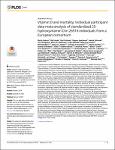Vitamin D and mortality: Individual participant data meta-analysis of standardized 25-hydroxyvitamin D in 26916 individuals from a European consortium
Gaksch, Martin
Jorde, Rolf
Grimnes, Guri
Joakimsen, Ragnar
Schirmer, Henrik
Wilsgaard, Tom
Mathiesen, Ellisiv B.
Njølstad, Inger
Løchen, Maja-Lisa
März, Winfried
Kleber, Marcus E.
Tomaschitz, Andreas
Grübler, Martin
Eiriksdottir, Gudny
Gudmundsson, Elias F.
Harris, Tamara B.
Cotch, Mary F.
Aspelund, Thor
Gudnason, Vilmundur
Rutters, Femke
Busch, Markus A.
Mensink, Gert
Scheidt-Nave, Christa
Thamm, Michael
Pilz, Stefan
Background: Vitamin D deficiency may be a risk factor for mortality but previous meta-analyses lacked standardization of laboratory methods for 25-hydroxyvitamin D (25[OH]D) concentrations and used aggregate data instead of individual participant data (IPD). We therefore performed an IPD meta-analysis on the association between standardized serum 25(OH)D and mortality. Methods: In a European consortium of eight prospective studies, including seven general population cohorts, we used the Vitamin D Standardization Program (VDSP) protocols to standardize 25(OH)D data. Meta-analyses using a one step procedure on IPD were performed to study associations of 25(OH)D with all-cause mortality as the primary outcome, and with cardiovascular and cancer mortality as secondary outcomes. This meta-analysis is registered at ClinicalTrials.gov, number NCT02438488. Findings: We analysed 26916 study participants (median age 61.6 years, 58% females) with a median 25(OH)D concentration of 53.8 nmol/L. During a median follow-up time of 10.5 years, 6802 persons died. Compared to participants with 25(OH)D concentrations of 75 to 99.99 nmol/L, the adjusted hazard ratios (with 95% confidence interval) for mortality in the 25(OH)D groups with 40 to 49.99, 30 to 39.99, and
No license information

